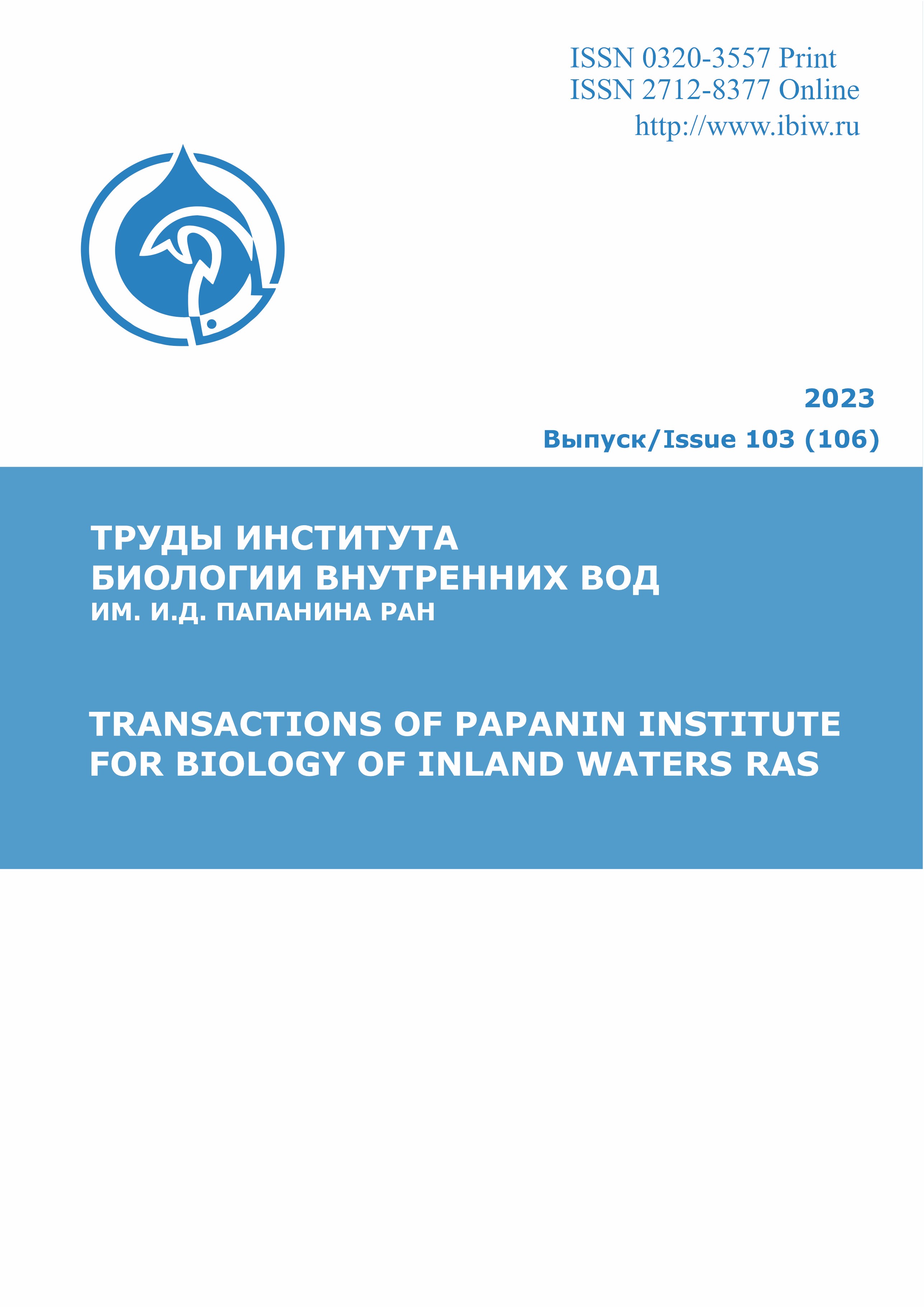UDC 595.324
Information on the species composition and distribution of zooplankton mycoparasites is summarized: 8 species of Chytridiomycota, 2 – Ascomycota, 7 – microsporidia, 19 – fungal-like organisms Oomycota. Known life cycles, dependence of infection spread on water temperature, density of host and parasite populations, host are given. The presence of saprotrophic species in plankton is indicated. They feed on dead inhabitants of plankton and introduced invertebrate corpses from terrestrial conditions: 30 species of Chytridiales, 4 – Mucorales and 35 species of fungus-like Saprolegniales. Information on the role of fungi in the nutrition of zooplankton is given, mainly zoospores and mitospore ascomycetes.
mycoparasites, saprotrophs, infection, zooplankton nutrition
1. Bravina I.V. Mikoflora komarov melkovodnyh zon Rybinskogo vodohranilischa i del'ty Volgi // Mikologiya i fitopatologiya. 1987. T. 21, Vyp. 1. S. 8-13.
2. Gerasimov Yu.V., Malin M.I., Borisenko E.S., Zhdanova S.M., Cvetkov A.I., Smirnov A.K. Pischevoe povedenie i pitanie ryapushki (Coregonus albula) v ozere Plescheevo v period temperaturnoy stratifikacii // Ozera Evrazii: problemy i puti ih resheniya. Materialy II Mezhdunarodnoy konferencii. Kazan': Akademiya nauk respubliki Tatarstan, 2019. S. 234-239.
3. Golubeva O.G. Chytridiomycetes. Vyp. 1. Por. Chytridiales. SPb.: Mir i sem'ya, 1995. 168 s.
4. Koval' E.Z. Opredelitel' entomofil'nyh gribov SSSR. Kiev: Naukova dumka, 1974. 260 s.
5. Pystina K.A. Rod Pythium Pringsh. Opredelitel' gribov Rossii: Klass Oomicety. Vyp. 2. SPb.: Nauka, 1998. 126 s.
6. Sokolova Yu.Ya. Proishozhdenie mikrosporidiy i ih polozhenie v sisteme eukariot // Mikologiya i fitopatologiya. 2009. T. 43, Vyp. 3. S. 177-192.
7. Batko A. Zarys hydromikologii. Warszawa: PWN, 1975.478 p.
8. Calabon M.S., Hyde K.D., Jones E.B.G., Bao D.F., Bhunjun C.S., Phukhamsakda C., Shen H.W., Gentekaki E., Al Sharie A.H., Barros J., Chandrasiri K.S.U., Hu D.M., Hurdeal V.G., Rossi W., Valle L.G., Zhang H., Figueroa M., Raja H.A., Seena S., Song H.Y., Dong W., El-Elimat T., Leonardi M., Li Y., Li Y.J., Luo Z.L., Ritter C.D., Strongman D.B., Wei M.J., Balasuriya A. Freshwater Fungal Biology // Mycosphere. 2023. Vol. 14. № 1. P. 195-413. DOI:https://doi.org/10.5943/mycosphere/14/1.
9. Calabon M.S., Hyde K.D., Jones E.B.G., Chandrasiri S., Dong W., Fryar S.C., Yang J., Luo Z.,L., Lu Y.Z., Bao D.F., Boonmee S. www.freshwaterfungi.org, an online platform for the taxonomic classification of freshwater fungi // Asian Journal of Mycology. 2020. Vol. 3. № 1. P. 419-445. DOI:https://doi.org/10.5943/ajom/3/1/14.
10. Czeczuga B., Czeczuga-Semeniuk E., Semeniuk-Grell A. Ecological diversity and economical importance of species from Aphanomyces genus // Afr. J. Agric. Res. 2016. Vol. 10 (48). P. 4356-4363. DOI:https://doi.org/10.5897/AJAR2015.9136.
11. Dallas T. Biotic and abiotic factors influencing hostpathogen dynamics in a zooplankton-fungus system. Athenes; Georgia: University of Georgia, 2016. 189 r.
12. Ebert D. Ecology, Epidemiology, and Evolution of Parasitism in Daphnia [Internet]. Bethesda (MD): National Library of Medicine (US), National Center for Biotechnology Information. 2005. Available from: http://www.ncbi.nlm.nih.gov/entrez/query.fcgi?db=Books
13. Garcia R.D., Jara F.G, Steciow M.M., Reissing M. Oomycete parasites in freshwater copepods of Patagonia: effects on survival and recruitment // Dis. Aquat. Org. 2018. Vol. 129. P. 128-134.
14. Garcia R.D., Jara F.G., Steciow M.M. Record of parasitic oomycetes on neotropical copepods in aquatic environments of Northwestern Patagonia (Argentina) // Acta Limnologica Brasilienses. 2020. Vol. 32. e16. DOI:https://doi.org/10.1590/S2179-975X0719.
15. Gleason F.H., Kagami M., Leferve E., Sime-Ngando T. The ecologyof chytrids in aquatic ecosystems: roles in food web dinamics // Fungal biology reviews. 2008. Vol. 22. № 1, P. 17-25. DOI:https://doi.org/10.1016/j.fbr.2008.02.001.
16. Gleason F.H., Marano A.V., Jonson P., Martin W.W. Blastocladian parasites of invertebrates// Fungal Biology Reviews. 2010. Vol. 24. № 1. P. 56-67. DOI:https://doi.org/10.1016/j.fbr.2010.03.004
17. Gleason F.H., Marano A.V., Lilje O., Lange L. What has happened to the ‘aquatic phycomycetes” (sensu Sparrow)? Part I: A brief historical perspective // Fungal Biology Reviews. 2017. Vol. 32. P. 26-33. DOI: 1016/j.fbr.2017.09.01.
18. Green J. Parasites and epibionts of Cladocera // Trans. Zool. Soc. London. 1974. Vol. 32. P. 417-515.
19. Hall S.R., Recker C.R., Duffy M.A., Cáceres C.E. Epidemic size determines population level effects of fungal parasites on Daphnia hosts // Oecologia. 2011. Vol. 166. P. 833-842. DOI:https://doi.org/10.1007/s00442-011-1905-4.
20. Johnson P.T.J., Stanton D.E., Preu E.R., Forshay K.J., Carpenter S.R. Dining on disease: how interactions between infection and environment affect predation risk // Ecology. 2006. Vol. 87. P. 1973-1980. DOI:https://doi.org/10.1890/0012-9658(2006)87[1973:DODHIB]2.0.CO;2.
21. Jonson P.T.J., Longcore J.E., Stanton D.E., Carnegie R.B., Shields J.D., Preu E.R. Chytrid infections of Daphnia pulicaria: development, ecology, pathology and phylogeny of Polycarium laeve // Freshwater Biology. 2006. Vol. 51. P. 634-648. DOI:https://doi.org/10.1111/j.1365-2427.2006.01517.x
22. Kagami M., von Elert E., Ibelings B.W., de Bruin A., Van Donk E. The parasitic chytrid, Zygorhizidium, facilitates the growth of the cladoceran zooplankters, Daphnia, in cultures of the inedible alga, Asteroinella // Proc. R. Soc. 2007. Vol. 274. P. 1561-1566. DOI:https://doi.org/10.1098/rspb.2007.0425.
23. Larson J.I.R., Ebert D., Várva J. Ultrastructural study of Glugea cladocera Pfeiffer, 1895, and transfer to the genus Agglomerata (Microspora, Dubosqiidae) // Europ. J. Protistol. 1996. Vol. 32. № 4. P. 412-422.
24. Lepère C., Domaizon I., Humbert J.-F., Jardillier L., Hugoni M., Debroas D. Diversity, spatial distribution and activity of fungi in freshwater ecosystems // Peer J. 2019. 7. e6247. DOI:https://doi.org/10.7717/peerj.6247.
25. Prόba D. Appearance of Sommerstorffia spinosa Arnaudov in Poland // Bull. Acad. Polon. Sci. C1. II. 1979. Vol. 27. № 8. P. 631-633.
26. Refardt D., Decaestecker E., Jonson P.T.J., Várva J. Morphology, molecular phylogeny, and ecology of Binucleata daphniae n.g., n.sp. (Fungi, Microsporidia), a parasite of Daphnia magna Straus, 1820 (Crustacea: Branchipoda) // J. Eucaryot. Microbiol. 2008. Vol. 55. № 5. P. 393. DOI:https://doi.org/10.1111/j.1550-7408.2008.00341.x.
27. Rocha J.R.S., Rocha F.P., Machado J.L. O gȇnero Myzocytopsis (Oomycota) no estado Piauί: novos regitros para o Brasil // Gala Scienta. 2017.Vol. 11. № 1. P. 98-115. DOI:https://doi.org/10.22478/ufpb.1981-1268.2017v11n1.34865.
28. Rosetti G. Fungal parasitism in freshwater calanojdpopulation: ecological consequences and possible mechanisms involvtd in the infection process// Hydrobiologia. 2005. Vol. 548. P. 167-176. DOI:https://doi.org/10.1007/s10750-005-4168-4
29. Scott W.W. A monograph of the genus Aphanomyces // Technical Bulletin. Virginia Agricultural experiment station. 1961. 95 p.
30. Sigee D.C. Freshwater microbiology. Biodiversity and dynamic interactions of microorganisms in the aquatic environment . Chichester: John Wiley et sons LTD, 2005. 524 p.
31. Sparrow F.K. Aquatic Phycomycetes. Ann Arbor: University of Michigan Press, 1960. 1188 p.
32. Thomas S.H., Housley J.M. The ecology and phylogeny of oomycete infections in Asplancha rotifers // Freshwater Biology. 2011. Vol. 56. № 2. P. 384-394. DOI:https://doi.org/10.1111/j.1365-2427.2010.02505.x.
33. Valois A.E., Bruns C.W. Parasites as prey: Daphnia reduse transmission of an oomycete broodparasite in the calanoid copepod Boeckella// J. Plankton Res. 2016. Vol. 38, № 5. P. 1281-1288. DOI:https://doi.org/10.1093/plankt/fbw055.
34. Voronin L.V. Terrigenous Micromycetes in Freshwater Ecosystems (Review) // Inland Water Biology. 2014. Vol. 7. № 4. P. 352-356. DOI:https://doi.org/10.1134/S1995082914040191.
35. Voronin L.V. Zoosporic fungi in freshwater ecosystems// Inland Water Biology. 2008. Vol. 1. № 4. P. 341-346. DOI:https://doi.org/10.1134/S1995082908040056.
36. Voronin L.V., Zhdanova S.M. Mycoparasite Infection of Daphnia cucullata Sars, 1862 (Crustacea, Cladocera, Daphniidae) in Lake Pleshcheyevo (Yaroslavl Oblast, Russia) // Inland Water Biology. 2021. Vol. 14, № 6. P. 792-796. DOI:https://doi.org/10.1134/S1995082921060146.
37. Whisler H.C., Zebold S.L., Shemanchuk J.A. Life history of Coelomomyces psorophorae// Proc. Nant. Acad. Sci U.S.A. 1975. Vol. 72. P. 693.
38. Wolinska J., Giessler S., Koerner H. Molecular identification and hidden diversity of novel Daphnia parasites from European lakes// Appl. Environ. Microbiol. 2009. Vol. 75. № 22. P. 7051-7059. DOI:https://doi.org/10.1128/AEM.01306-09
39. Wolska M., Mazurkiewicz-Zapałowicz K. Parasites of zooplankton and periphyton assemblages in the littoral zone of lakes in Drawa National Park, Poland // Acta Mycol. 2013. Vol. 48. №1. P. 51-59. DOI:https://doi.org/10.5586/am.2013.007
40. Wurzbacher C.M., Bӓrlocher F., Grossart H.-P. Fungi in lake ecosystems //Aquat Microb Ecol. 2010. Vol. 59. P. 125. DOI:https://doi.org/10.3354/ame01385.








